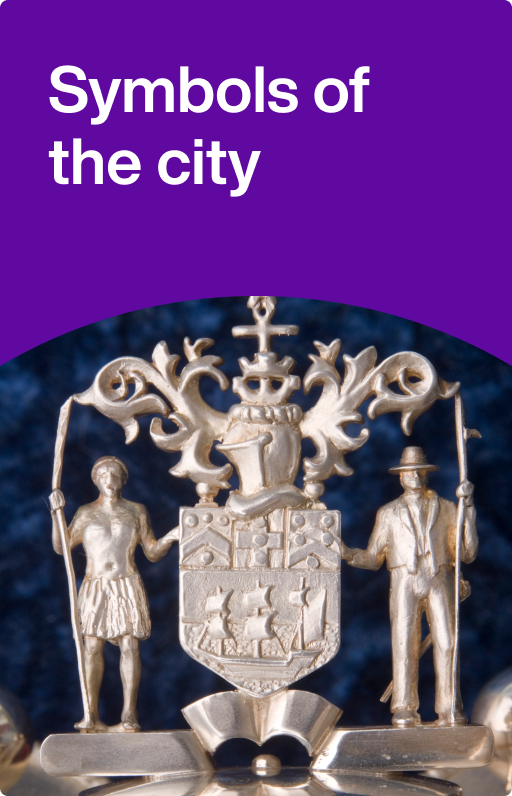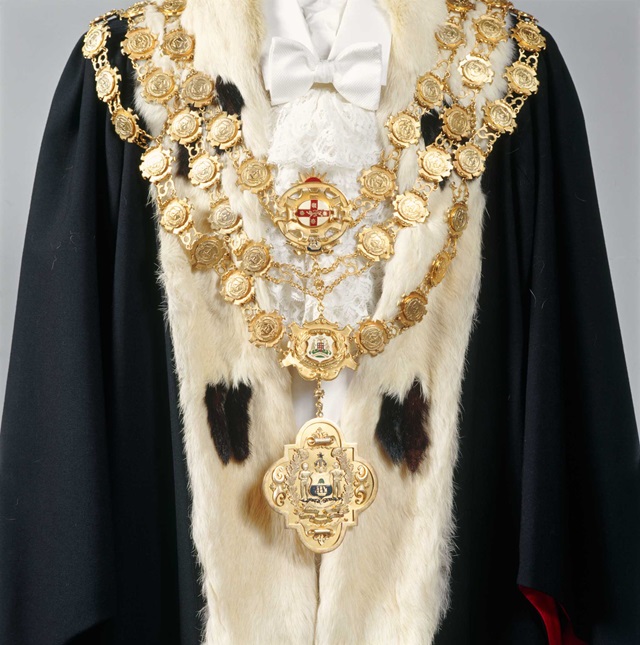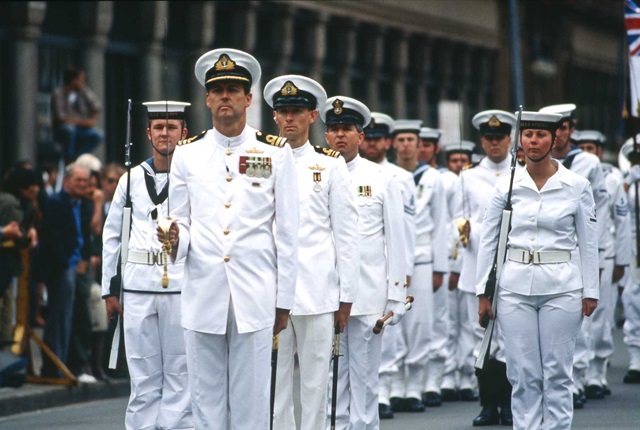Symbols of the city
Our coat of arms, flag and flower, and symbolic honours like the keys and freedom of the city.

The official symbols of the City of Sydney have a rich history.
Over the years the City has changed its Coat of Arms – the first version included a shield supported on one side by an Aboriginal man, and on the other by a British sailor.
The City's flag includes the shield from the Arms granted by the College of Arms in London on 30 July 1908.
Sydney has its own official flower – the Banksia ericifolia was officially adopted in 1992 as part of the sesqui celebrations of Council, serving as a symbol of Australia's oldest city.
The granting of the Key to the City is a symbolic presentation that represents the highest honour a city can confer on an individual or an organisation.
Freedom of Entry to the City is granted to a military or civilian unit allowing them entry to the city "with bayonets fixed, colours flying and drums beating".
The mace, originally a close quarters weapon favoured in medieval times, became a symbol of royal authority and protection. Sydney's mace was commissioned in 1992.
Mayoral chains of office became popular as accompaniments to municipal dress during the reign of Queen Victoria. In 1902 the Sydney Chamber of Commerce initiated the first link of a civic chain.
The original civic robe for the Mayor of the City of Sydney in 1842 was purple trimmed with ermine with a Court dress hat. The current robes worn by the Lord Mayor and Deputy Lord Mayor are black and those of the Councillors are blue. Nowadays formal robes are worn only at major civic functions.



Adopted in 1996, the City of Sydney's coat of arms adapts elements of an earlier design granted by the College of Arms in 1908.
In 1842 one of the first duties of the newly declared city was to acquire a seal to authenticate documents. The first example was simply inscribed with the Council's name and the date it was incorporated. 15 years later, a draughtsman in the City Surveyors Department, Monsieur de St Remy, designed a new seal using heraldic symbols denoting aspects of the city’s history.
The shield featured, as its main charge, a ship reflecting Sydney’s maritime history. Above this, in the upper third of the shield (known as the chief) was a rising sun – later replaced by a beehive, the symbol of industry. The shield was supported on one side by an Aboriginal man, and on the other by a British sailor. The motto “I take but I surrender” was inscribed on a scroll beneath the shield.
Although de St Remy’s original design was never formally submitted to the English Kings of Arms for a formal grant, it was the basis for subsequent developments and was used with slight variations throughout the 19th century.
In 1902 the City of Sydney was granted a Royal Warrant, which created the Lord Mayoralty as a “mark of respect for the standing of the city in the Empire”. Sydney’s first Lord Mayor, Thomas Hughes recommended the City of Sydney commission a new coat of arms and submit a petition to be granted by the English Kings of Arms in London.
The new design created by Sydney heraldic designer, William Frederic Ward, used some of de St Remy’s features. In place of the rising sun, the chief now honoured individuals significant in the history of Sydney. It featured the arms of Thomas Townshend (Viscount Sydney), after whom the city was named.
It also included the Naval Flag of England in the centre, denoting the contribution of Arthur Phillip in the foundation of the colony, overlaid with a globe and 2 stars, the principal features of the posthumous arms of James Cook. The final version, which was granted by the English Kings of Arms in 1908, included the arms of Lord Mayor Hughes.
The modern version of the coat of arms features a shield charged with a crown and anchor, both traditional heraldic symbols that have long been the images associated with the city. The anchor represents the fact a naval officer claimed Australia for the Crown, with Sydney Harbour the site for settlement.
The mural crown denotes the power and authority of a city. The upper third of the shield, remains divided vertically into thirds and features simplified versions of the arms of Thomas Townshend, Captain Cook and Sir Thomas Hughes.
Together, these symbols represent the naming of Sydney, the British contribution to the establishment of Sydney, and Sydney's emergence as a great maritime port city. The 6 pointed star, or “mullet”, above the shield is a traditional motif derived from European heraldry. The human figures have been removed, along with the motto, and replaced by a serpent and a coiled rope flanking the shield.
Seal
The design is used on the the City of Sydney’s seal, which authenticates documents and deeds with a clearly recognisable ‘corporate signature’.
Its use is based on a medieval English tradition. It has no effect unless accompanied by the signatures of those members of Council who are present when the seal is applied.
The original seal comprised text which read: “Seal of the Mayor, Aldermen, Councillors and Citizens of the City of Sydney, Incorporated 1842”. Following the official recognition of the Council’s coat of arms by the College of Heralds in 1908, a new seal was made that incorporated the coat of arms.
Mace
In 1992 the Friends of Sydney Town Hall commissioned a mace to commemorate the City of Sydney's 150 year anniversary.
A mace is a close-quarters weapon that was favoured in medieval times. Originally, it became a symbol of royal authority and protection and is now a ceremonial item for many councils.
Sydney’s version was made by South Australian silversmith John Hale and features some of the architectural icons of Sydney and motifs relating to the role of the Council.
Chain
Mayoral chains of office became popular during Queen Victoria’s reign. In 1902 the Sydney Chamber of Commerce initiated the first link of a civic chain. In the following year the Governor of NSW, Sir Harry Rawson, presented Sydney's first Lord Mayor Thomas Hughes with the chain of office.
The chain comprised gold and enamel medallions featuring the coat of arms of the Sydney Chamber of Commerce and the Stock Exchange, and a pendant depicting the city's coat of arms.
Former and successive mayors contributed a small gold medallion where their terms of office were embossed. By 1945 this practice was discontinued because of the size and weight of the chain. Today, the chain is worn with the robes of office on rare civic occasions, with a smaller collar used for most formal civic duties.
Robes
Civic robes date to medieval England when mayors were responsible for law and order within their cities. As magistrates, mayors assumed the traditional judicial dress as a symbol of authority.
The original mayoral robe in 1842 was purple, trimmed with ermine and a court dress hat. Mayors also wore a jabot or neck ruffle and white gloves.
The robes worn today by the Lord Mayor and Deputy Lord Mayor are black and those of the Councillors are blue. They are worn rarely and only at major civic functions.
Presenting a symbolic key to the city is the highest honour a city can confer upon an individual or an organisation.
The tradition dates back to medieval times when many cities were enclosed within walled fortifications. The key symbolised the political relationship between a city and the king or ruler of the land where it was located.
When the ruler visited the city for the first time after assuming power, authorities would formally greet him at the gates and hand over a key to signify the city was now under his control. The key would then be returned by the ruler to acknowledge he intended to respect the political authority of those who administered the city.
The key to the City of Sydney is traditionally presented by the Lord Mayor at a civic ceremony. It's presented to acknowledge the contribution an individual or organisation has made to further the ideals of the city, or to recognise outstanding achievement in sport or humanitarian work at an international level.
Among others, the key to the City of Sydney has been awarded to Nelson Mandela (1990), Dame Joan Sutherland (1991), Jørn Utzon (1998), Juan Antonio Samaranch (2000), Aung San Suu Kyi (2003), John Bell AO (2015), Jan Gehl (2017) and various Australian Olympic, Paralympic and other sporting teams and personalities.
Freedom of entry to the city is a ceremonial honour that became popular during the 19th century, which draws some inspiration from medieval history.
A military or civilian unit accorded this privilege is granted the right of entry to the city “with bayonets fixed, colours flying and drums beating”.
This award is restricted to Australian military and civilian units that have, through their command, a significant attachment to the city. It is conferred in recognition of their achievement while on active service or overseas duty, or as a mark of respect and gratitude for their efforts in the defence of Australia.
Freedom of entry to the city is celebrated with a parade of the unit through the city streets to Sydney Town Hall and the presentation of a scroll and the city's flag.
The City of Sydney's flag design incorporates features from the City of Sydney’s coat of arms.
The flag is a horizontal triband of 3 colours – white, gold and blue. The top third features 3 designs. In the top left the arms belong to Thomas Townshend, Viscount Sydney after whom the city was named.
The English Naval Flag in the centre acknowledges the role Arthur Philip played in Sydney’s foundation.
The red cross is overlaid with a globe and 2 stars – the principal features of James Cook’s Arms, which were granted as a posthumous honour for his service in mapping Australia.
The arms in the top right belong to the first Lord Mayor of Sydney, Thomas Hughes. It was during his term of office that the title of Mayor became Lord Mayor, and the official coat of arms for the city was granted.
The remaining field of the flag features a ship under full sail, an allusion to the prominence of Sydney as a maritime port.
Officially adopted in 1992 as part of the City's 150 year anniversary celebrations, the Banksia ericifolia serves as a symbol of Australia’s oldest city.
The orange-rusty coloured banksia was first documented by Sir Joseph Banks when Captain Cook came to Botany Bay in 1770. The species, which is indigenous to the foreshores of the harbour and heathlands along the coast, still survives in abundant numbers.
“This Banksia was the winter life blood of the Wadi Wadi people of the Illawarra. They left the beaches to winter on our escarpment ... winter threatened no bushfires and the Banksia yielded all their food requirements. Nectar supplied sugar and gill birds (large flocks) moved in on this syrup which in turn gave them all the meat. Fuel came from the cobs which burn cleaner and far better than coal or coke ... (it was) a complete life support system.”
Noel Carr, Australian and New Zealand Society of Ecologists, 1992.
The flowers are formal in appearance and have formed the basis of the floral arrangements sent to Sydney's sister city, Nagoya for its annual floral festivals.
“There is, I think, no more decorative plant in the bush than this particular Banksia, when the bottle brushes are newly-opened and the little hooked styles are deep red with yellow tips. A bunch of them arranged with their own green in a big bronze jar is a sight to gladden a whole household."
An excerpt from ‘A Bush Calendar’ by Amy E Mack, 1909.


